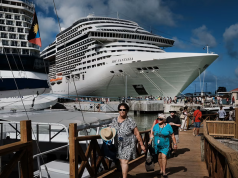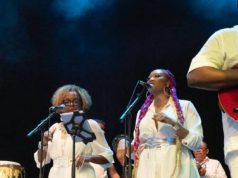

LUX magazine recently featured Puerto Rican artist Enoc Pérez in conversation with contributing editor Maryam Eisler. Here are excerpts; read the full interview and view more artwork by Pérez at Lux: Responsible Culture.
Borne of 1980s New York amongst the backdrop of Warhol, Basquiat, and Felix Gonzalez-Torres, Puerto Rican artist Enoc Perez has spent his decades-long career exploring questions of identity, heritage, and the urban landscape. LUX Contributing Editor Maryam Eisler talks to him about love, the ‘second phase of life’, and art in the current climate.
Maryam Eisler: We’re sitting in your summer studio in East Hampton.
Enoc Perez: I call it the two-car garage; it’s a studio where my children used to run in as children. This is also where I learned how to make sculptures. I’ve even made little pastoral paintings, something I would not normally do.
[. . .] ME: You told me earlier that this is now the second phase of life; talk to me about your beginnings.
EP: I came here when I was 19 years old from Puerto Rico. I wanted to come here, and my dad insisted on that too – if I was going to study art, I had to go to America. He was right. When I graduated at 22, the whole challenge was how to get seen in a city that has so many artists. It was 1986. Jean-Michel [Basquiat] was still working. I was there. I witnessed it all.
[. . .] ME: You were a clean slate, ready to absorb.
EP: At first, I did my own interpretations of Jean-Michel Basquiat because he was the best. Until I realised that I had to do something that nobody else had attempted or wanted to do, especially as a Puerto Rican. In the early 90s, Felix Gonzalez-Torres started to come to prominence, and he was a game changer – how he saw sculpture and art was mind blowing. I noticed that Felix would be placed into contemporary art auctions, not in Latin American sales. That’s when I decided I didn’t want to be separated.
So, I decided to win the contemporary. Then came questioning of the method. How would I communicate with my audience using a universal language? I looked at Warhol, Rauschenberg, Richard Prince: they all used printmaking in the painting process, especially Warhol and Rauschenberg. That’s when I started doing transfers of drawings. [. . .]
ME: Love is everything.
EP: Isn’t it? It’s probably the most basic motivation. But when you’re already in love you have to become more conceptual and talk about intellectual matters.
So, I met Carole. She was married to some other guy, but I wanted to do a show about her, and I decided to do a show in code. This was 2003. I thought to myself, ‘what am I going to do?’. I have a good library of architecture books. There’s a hotel in Puerto Rico called the Normandie. The story of that hotel goes back to the Puerto Rican guy who built it. He had a French wife – a singer. He built a boat for her, but that didn’t work out, so she wasn’t too impressed. Then he built this building based on the famous Normandie liner boat. I said to myself, ‘I am a Puerto Rican and I’m in love with a French woman. This painting will be a portrait of her’. And that was that! [. . .]
ME: I also sense this idea of bygone past, some sort of melancholic nostalgia in your work, or a nod to sentimental elegance of the past which we seem to have lost today.
EP: I don’t know if it’s nostalgia. I think it’s about wanting to reclaim a time that only belongs to me.
ME: Your representation of this time looks a bit disjointed, like fragmented memories.
EP: It’s fractured, kind of like myself. When I started to do the Rum Paintings, for example, those were self-portraits. I was an alcoholic at the time. [. . .]
ME: But you are painting as you did, with sobriety. The canvas is ultimately your own skin. I am very intrigued by your use of calligraphy; even that is of the past.
EP: Maybe I am allowing myself to do that more today. I am having a show in Hong Kong with Ben Brown with my Rum Paintings and I have used words like ‘Go Bananas’, encouraging the alcoholic to get worse! Or ‘it’s nice to know you’re loved amongst friends’ shown with empty bottles. Poetic, right? [. . .]
For full article, visit https://www.lux-mag.com/a-conversation-with-artist-enoc-perez/
[Shown above: Artist Enoc Pérez in his home, photographed by Maryam Eisler.]
LUX magazine recently featured Puerto Rican artist Enoc Pérez in conversation with contributing editor Maryam Eisler. Here are excerpts; read the full interview and view more artwork by Pérez at Lux: Responsible Culture. Borne of 1980s New York amongst the backdrop of Warhol, Basquiat, and Felix Gonzalez-Torres, Puerto Rican artist Enoc Perez has spent his





